Lab 05 – Power Apps Component Framework
Scenario
A regional building department issues and tracks permits for new buildings and updates for remodeling of existing buildings. Throughout this course you will build applications and automation to enable the regional building department to manage the permitting process. This will be an end-to-end solution which will help you understand the overall process flow.
In this lab you will develop a custom component control using the Power Apps Component Framework (PCF). This component will be used to visualize the permit inspection history timeline. As you build the component, you will see how to use prescriptive interfaces of the framework to interact with the hosting form data. To speed things up we will use a community timeline library to render the visualization. When you build such controls, you can either follow the same procedure or use popular frameworks like React or Vue to completely control the visualization that the component will render.
High-level lab steps
As part of building this component, you will complete the following steps:
-
Use the Power Apps CLI to initialize the new component
-
Build the component logic using Typescript
-
Publish the component for use on forms
-
Configure the permit form to use the component
This is what the component will look like when it is completed.

Things to consider before you begin
-
What are the advantages of using a Power Apps Component Framework component over an embedded Power Apps canvas app?
-
Remember to continue working in your DEVELOPMENT environment. We’ll move everything to production soon.
Exercise #1: Create the PCF Control
Objective: In this exercise, you will create a Power Apps Components Framework control using the Power Apps CLI
Task #1: Install Microsoft Power Apps CLI and Prerequisites
-
Install Node.js
-
Navigate to Node JS
-
Select the latest LTS version.
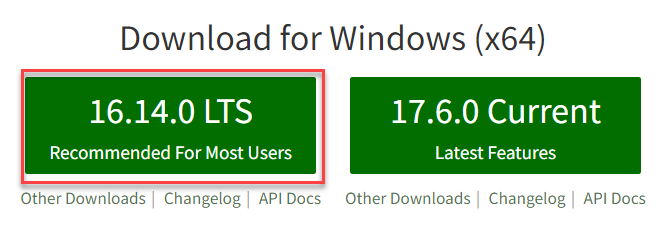
-
Open the downloaded file.
-
Follow the steps in setup wizard to complete installing Node.js
-
-
Install .NET Framework 4.6.2 Developer Pack
-
Navigate to Download .NET Framework 4.6.2
-
Select the Developer Pack.

-
Run the downloaded file.
-
Follow the steps in setup wizard to complete installing the Developer Pack.
-
Task #2: Setup Components Project
-
Start the developer command prompt tool
- Launch to start the developer command prompt from the start menu.
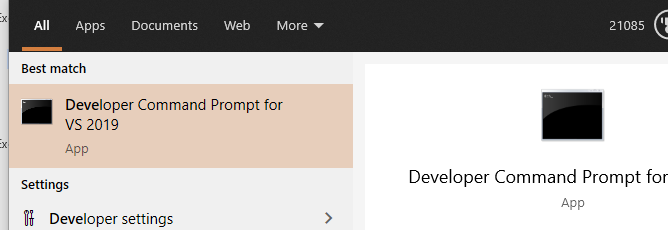
-
Create a new folder in your Documents folder and work in that directory
-
Run the command mentioned below to change directory. Replace [Computer User Name] with your OS user name.
cd C:\Users\[Computer User Name]\Documents -
Run the command mentioned below to create a new folder with name pcfTimelineControl.
mkdir pcfTimelineControl -
Run the command mentioned below to switch to the pcfTimelineControl folder.
cd pcfTimelineControl

-
-
Create a new folder in the pcfTimelineControl folder, name it src, and work in that directory
-
Create a new folder with the name src, by running the command below.
mkdir src -
Run the command below to switch to the src folder you just created.
cd src -
Clear the screen by running the command below.
cls
-
-
Install the latest Power Apps CLI, create a solution project with the name timelinecontrol, namespace contoso, and template dataset
- Install latest Power Apps CLI version. Use: https://aka.ms/PowerAppsCLI
Note: if you just installed the tools, you already have the latest, however, you can run this command anytime to ensure you are always up to date.
Note: If you get an error that npm is not a recognized command, you will need to re-run the nodejs installer and make sure to choose Chocolatry. This will run a PowerShell script as part of the install which may have been missed during the first install attempt.
pac install latest
- Initialize the component. This command will create a set of files that will implement a dataset component. You will customize these files as we continue.
pac pcf init --name timelinecontrol --namespace contoso --template dataset
- Install dependencies by running **npm install** command in the Terminal
npm install
- Wait for the dependency installation to complete.
-
Open the src folder in Visual Studio Code and review the generated resources
-
Open the src folder in Visual Studio Code. For this to work, make sure that the Visual Studio Code is added to Path in Environment Variables.
code . -
Visual Studio Code should start, and it should open the src folder.
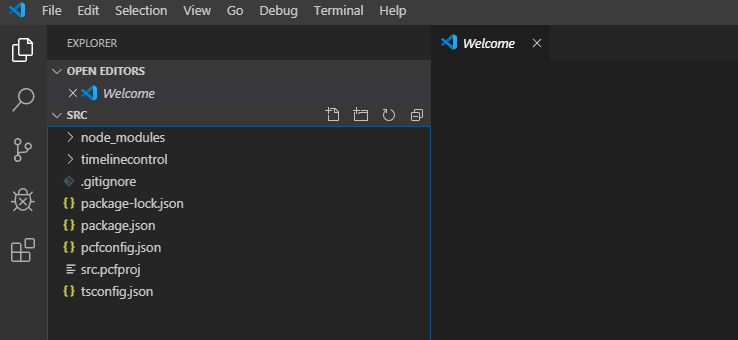
-
Expand the timelinecontrol folder.
-
Open the ControlManifest.Input xml file and examine it.
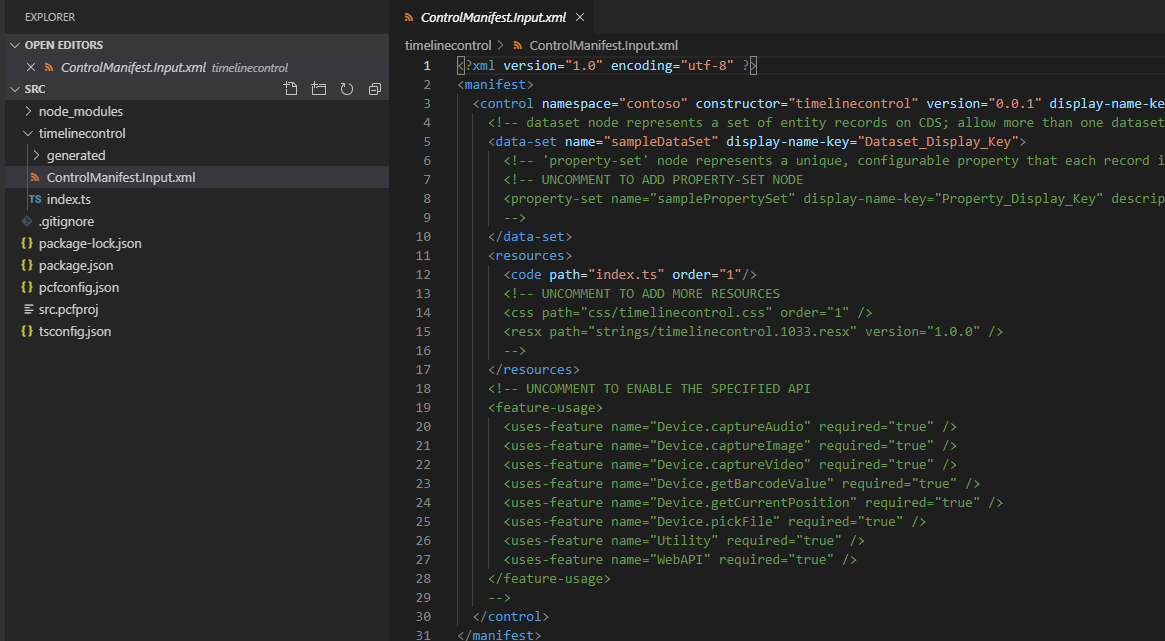
-
Open the Index.ts file and examine it.
-
Expand the generated folder.
-
Open the ManifestTypes file and examine it.
-
-
Open CLI in visual studio code
- Select Terminal and select New Terminal. If Terminal is not visible in the menu, you can open it by selecting View -> Integrated Terminal.

- If cmd isn’t your Default Shell, select the arrow and then select Select Default Shell.
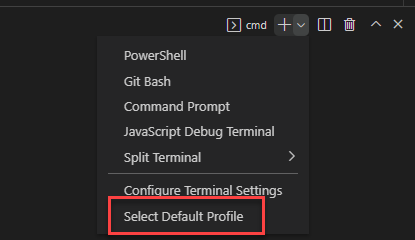
- Select Command Prompt.

- Select New Terminal.

- The cmd terminal should now open.

-
Run the Build command and review the out folder
-
Run npm build in the terminal
npm run build -
You should now be able to see the out folder. Expand the folder and review its content.
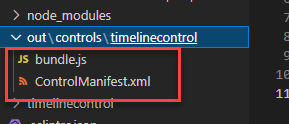
-
-
Run the Start command to start the test harness
-
Run npm start in the terminal
npm start -
This should open the Test Environment in a browser window.
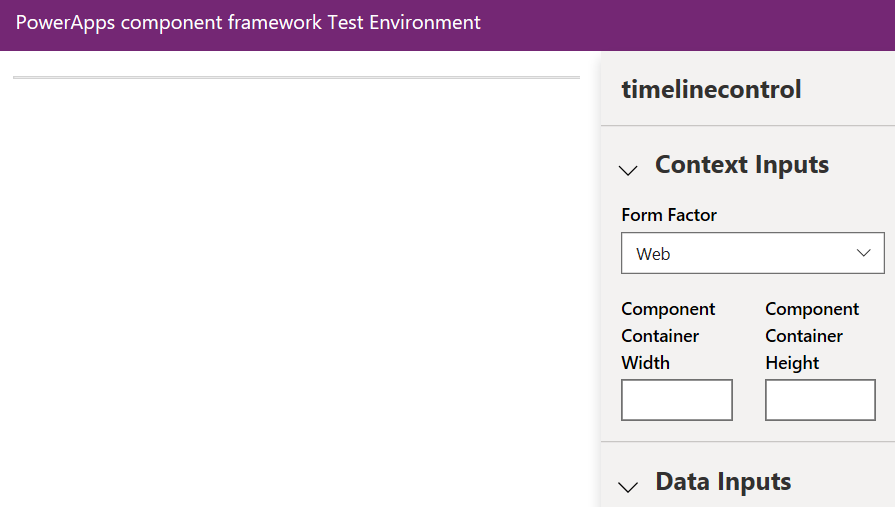
- The Component container size should change, if you provide Width and Height.
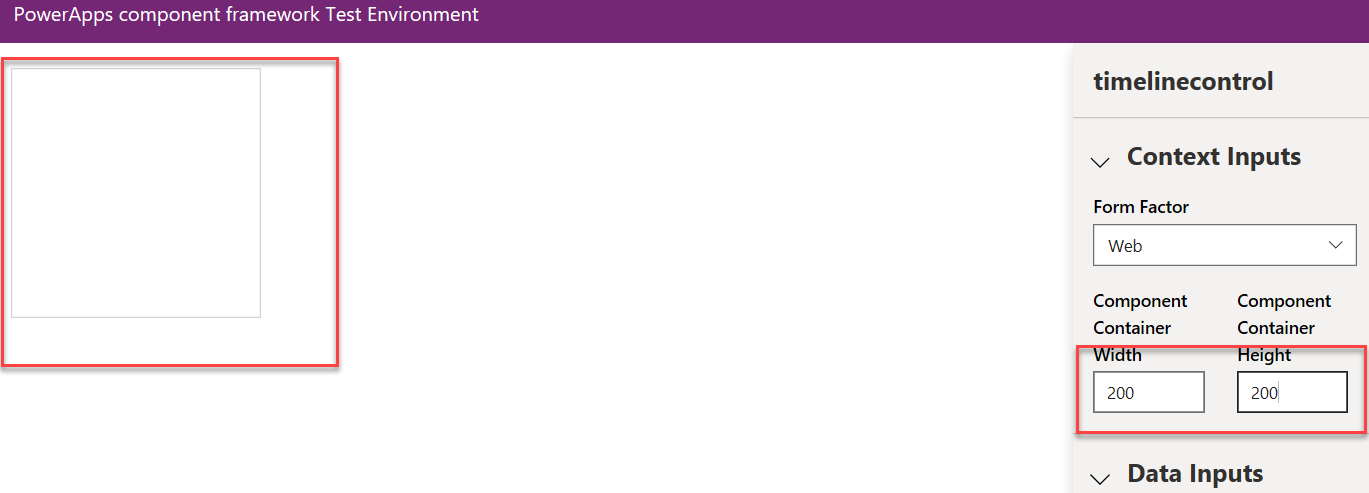
-
-
Stop the test harness
-
Close the Test Environment browser window or tab.
-
Go back to Visual Studio Code.
-
Click on the Terminal and press the [CONTROL] key and c.
-
Type y and [ENTER].

-
-
Create a new solution folder in the parent of the src folder pcfTimelineControl and switch to it
-
Change directory to the pcfTimelineControl folder.
cd .. -
You should now be in the pcfTimelineControl directory.

-
Create a new folder with the name solution.
mkdir solution -
Switch to the solution directory.
cd solution -
You should now be in the solution directory.

-
-
Create solution project and add reference of the src folder where the component is located to the solution. This configuration will be used when you are done with your development and ready to publish your component for others to use.
-
Create solution project with name and prefix contoso.
pac solution init --publisher-name contoso --publisher-prefix contoso -
Add component location to the solution. This creates a reference to include your component when the solution build command is run.
pac solution add-reference --path ..\src -
The project reference should be added successfully.

-
-
Build the solution
-
Make sure you are still in the solution folder.
-
Build the project by running the command below.
msbuild /t:restore -
The build should succeed.

-
Task #3: Build the Basic Timeline
-
Change directory to the src folder
-
Change directory to the src folder.
cd ..\src
-
-
Create css folder in the timelinecontrol folder and create timelinecontrol.css file in the css folder
- Select the timelinecoltrol folder and then select New Folder.

-
Name the folder css.
-
Select the css folder you created and then select New File.
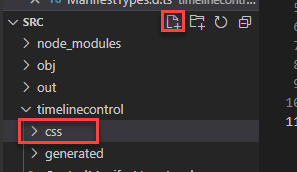
- Name the new file timelinecontrol.css.
-
Add the css as resource
-
Open the ControlManifest.Input.xml file.
-
Locate the resources sub element and uncomment the css tag, change the Order to 2.
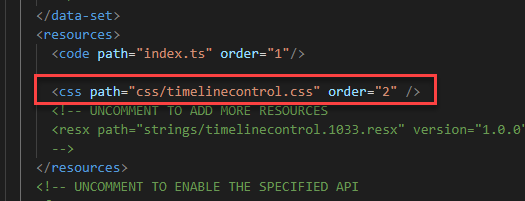
-
-
Change the data-set name to timelineDataSet.
- Locate data-set tag and change the name property to timelineDataSet.

-
Install vis-timeline css npm package
-
Go to the Terminal and make sure you are in the src directory.
-
Run the command mentioned below and wait for the packages to be added.
npm install vis-timeline

-
Run the command mentioned below and wait for the packages to be added.
npm install moment -
Run the command mentioned below and wait for the packages to be added.
npm install vis-data
-
-
Add the vis-timeline css as a resource
-
Go back to the ControlManifest.Input.xml file.
-
Add the vis-timeline css inside the resources tag.
<css path="..\node_modules\vis-timeline\dist\vis-timeline-graph2d.min.css" order="1" />

-
-
Add timeline element and visual properties to the Index file
-
Open the Index.ts file.
-
Add the properties below, inside the export class timelinecontrol function.
private _timelineElm: HTMLDivElement; private _timelineVis : any;

-
Add the below constant after the import lines on the top.
const vis = require('vis-timeline');

-
-
Build the timeline element as div and add it to container element as a child
-
Locate the init function.
-
Add the script mentioned below to the init function.
this._timelineElm = document.createElement("div"); container.appendChild(this._timelineElm);

-
-
Create a function that will render the timeline
-
Add the function below.
private renderTimeline(): void { // Create a DataSet (allows two way data-binding) var items = [ { id: 1, content: 'item 1', start: '2020-08-20' }, { id: 2, content: 'item 2', start: '2020-08-14' }, { id: 3, content: 'item 3', start: '2020-08-18' }, { id: 4, content: 'item 4', start: '2020-08-16', end: '2020-08-19' }, { id: 5, content: 'item 5', start: '2020-08-25' }, { id: 6, content: 'item 6', start: '2020-08-27', type: 'point' } ]; // Configuration for the Timeline var options = {}; // Create a Timeline var timeline = new vis.Timeline(this._timelineElm, items, options); }
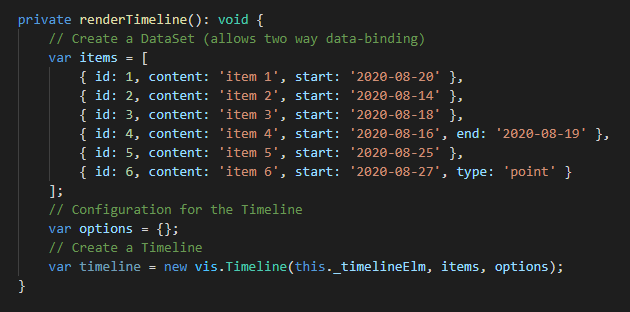
-
-
Call the renderTimeline function from the updateView function
-
Locate the updateView function.
-
Add the script mentioned below inside the updateView function.
this.renderTimeline();

- Select File and then select Save All.
-
-
Build and start
-
Go to the Terminal and make sure you are still in the src directory.
-
Run the build command.
npm run build -
The build should succeed.
-
Run the start watch command. This command will keep the test environment running and auto update when you change the component.
npm start watch

-
Do not close the test environment.
Task #4: Tailor for Inspection Data
In this task, you will switch from using the hard-coded array of data to using a file loaded into the test harness.
-
Create test data csv file
- Select the src folder and then select New File.

-
Name the new file testdata.csv
-
Add the below mentioned data inside the testdata.csv file and Save it.
contoso_permitid,contoso_name,contoso_scheduleddate,statuscode 123,Electrical:Rough Inspection:Passed,8/1/2020,Passed 124,Electrical:Rough Inspection:Passed,8/5/2020,Passed 125,Plumbing:Rough Inspection:Failed,8/8/2020,Failed 126,Plumbing:Rough Inspection:Passed,8/10/2020,Passed

-
Create Timeline Data class
-
Open the index.ts file.
-
Paste the code below after the type DataSet line.
class TimelineData { id: string; content: string; start: string; className: string; constructor(id: string, content: string, start: string, className: string) { this.id = id; this.content = content; this.start = start; this.className = className; } }

-
Add the timeline data array property inside the export class timelinecontrol function and below the _timelineElm definition.
private _timelineData : TimelineData[] = [];

-
-
Add a method that will create the timeline data.
-
Add the method mentioned below after the render method.
private createTimelineData(gridParam: DataSet) { this._timelineData = []; if (gridParam.sortedRecordIds.length > 0) { for (let currentRecordId of gridParam.sortedRecordIds) { console.log('record: ' + gridParam.records[currentRecordId].getRecordId()); var permitName = gridParam.records[currentRecordId].getFormattedValue('contoso_name') var permitDate = gridParam.records[currentRecordId].getFormattedValue('contoso_scheduleddate') var permitStatus = gridParam.records[currentRecordId].getFormattedValue('statuscode') var permitColor = "green"; if (permitStatus == "Failed") permitColor = "red"; else if (permitStatus == "Canceled") permitColor = "yellow"; console.log('name:' + permitName + ' date:' + permitDate); if (permitName != null) this._timelineData.push(new TimelineData(currentRecordId, permitName, permitDate, permitColor)); } } else { //handle no data } }
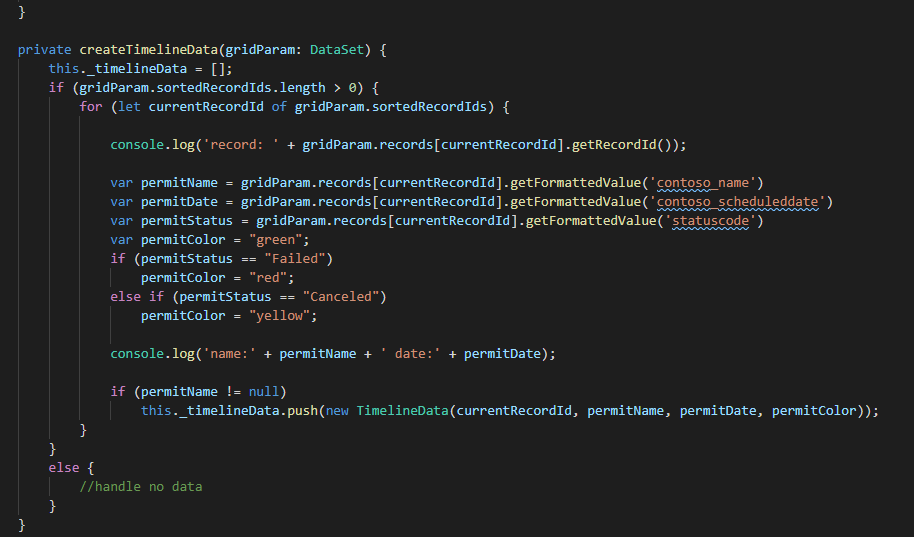
-
-
Call the createTimelineData method from the updateView method.
-
Go to the updateView method.
-
Replace the code inside the updateView method with the code below.
if (!context.parameters.timelineDataSet.loading) { // Get sorted columns on View this.createTimelineData(context.parameters.timelineDataSet); this.renderTimeline(); }

-
-
Replace the hardcoded items with the csv data.
-
Locate the renderTimeline function.
-
Replace the hardcoded items with code below.
var items = this._timelineData;

-
-
Make sure the test environment shows your changes and test the timeline control with the test data.
-
Select File and then Save All.
-
The test harness should still be running. If it is not running run npm start watch command.
-
Go to the test environment and make sure it looks like the image below.

- Select + Select a File.
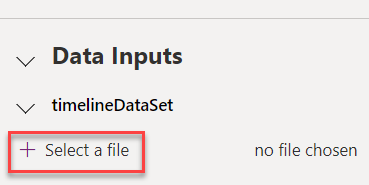
- Select the testdata.csv and then select Open.

- Select Apply.
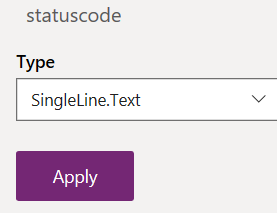
- The timeline control should now show the test data.

-
Do not close the test environment.
Task #5: Change Color for Items
In this task, you will use the css resource you configured to change the color of the items on the timeline.
-
Add red and green styles to the timelinecontrol.css file
-
Go back to Visual Studio Code.
-
Expand the css folder and open the timelinecontrol.css
-
Add the style below to the timelinecontrol.css file and save your changes.
.red{ background:red; color:white; } .green{ background:green; color:white; } .yellow{ background:yellow; color:black; }
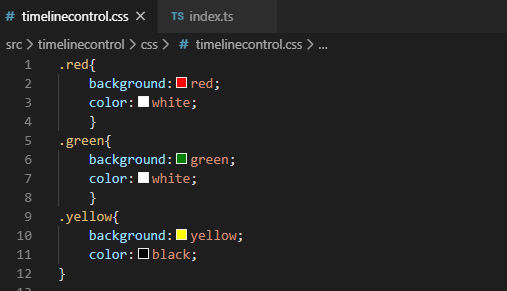
-
-
Check the test environment, load the test data and make sure it shows your changes
-
Go to the Test Environment.
-
Select + Select a File.
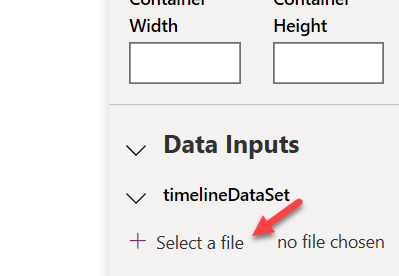
-
Select the testdata.csv and then select Open.
-
Select Apply.
-
The timeline control should now show the test data.

- Close the test environment browser window or tab.
-
-
Stop the test
-
Go back to Visual Studio Code.
-
Click on the Terminal and press the [CONTROL] key and c.
-
Type y and [ENTER].
-
Exercise #2: Publish to Microsoft Dataverse
Objective: In this exercise, you will publish the timeline control to your Microsoft Dataverse and add it to the Permit main form.
Task #1: Setup and Publish
-
Get your environment URL
-
Navigate to Power Platform admin center and select environments.
-
Locate and open your Dev environment.
-
Right click and copy the Environment URL.
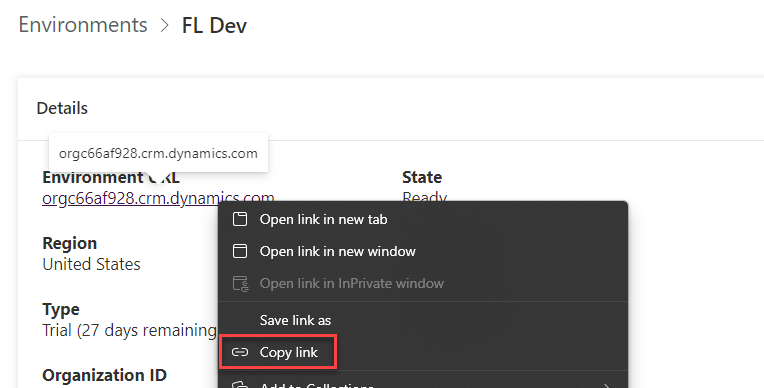
-
-
Authenticate
-
Go back to Visual Studio Code.
-
Make sure you are still in the src directory.
-
Run the command below. Replace <Environment URL> with the URL you copied.
pac auth create --url <Environment URL> -
Sign in with your admin username.
-
-
Import the solution into your org and publish
-
Run the command below and wait for the publishing to complete. The push command uploads your component to the configured environment. This can be used over and over during development to quickly see your component in the live form.
pac pcf push --publisher-prefix contoso

-
Task #2: Add Timeline Control to the Permit Form
-
Open the Permit Management solution
-
Navigate to Power Apps maker portal and make sure you have the Dev environment selected.
-
Select Solutions.
-
Open the Permit Management solution.
-
-
Open the Permit Main form and switch to classic
- Select Tabled and open the Permit table.

-
Select the Forms tab.
-
Open the Main form.
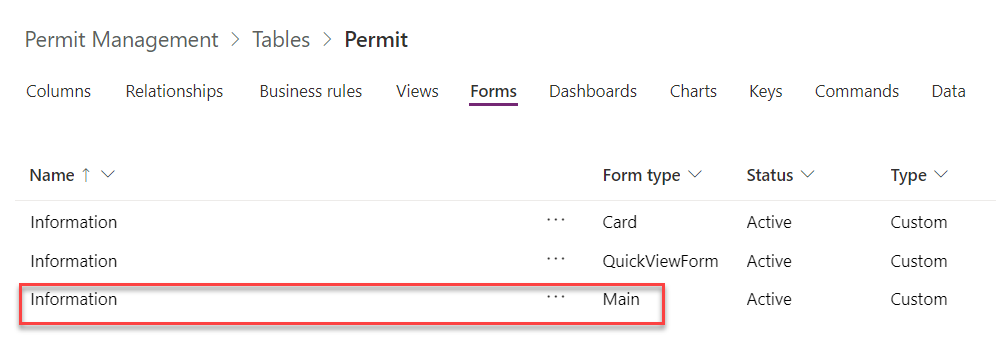
- Select Switch to Classic.

-
Add Timeline control to the form
-
Locate the Inspections tab.
-
Double click on the Inspections sub-grid.

- Select the Controls tab and select Add Control.

- Select timelinecontrol and select Add.
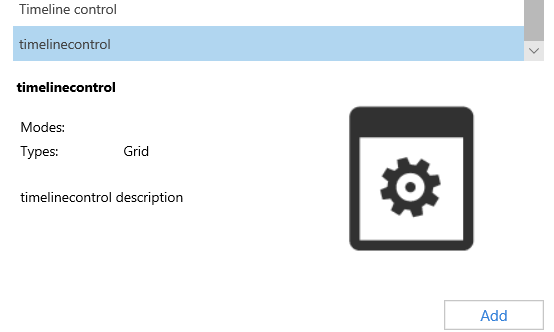
- Select Web and and then select OK.
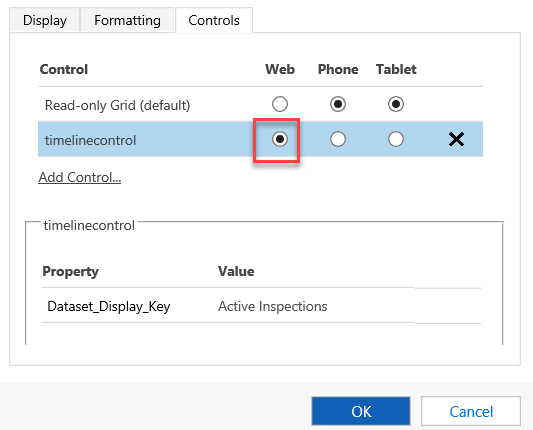
-
-
Save and publish
-
Select Save.
-
Select Publish and wait for the publishing to complete.
-
DO NOT close the form editor.
-
-
Create test data
-
Go back to Power Apps maker portal and make sure you have the Dev environment selected.
-
Select Apps and launch the Permit Management application
-
Select Advanced Find.

- Select Inspections and then select Results.
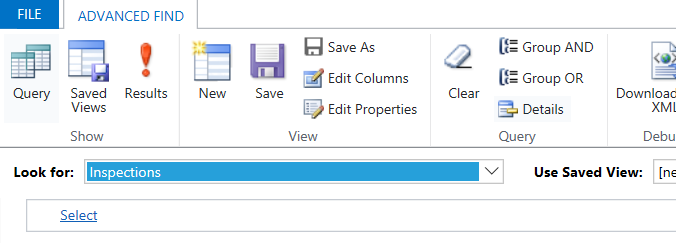
-
Open the Framing Inspection.
-
Change the Status Reason to Passed and select New.

- Provide a Name, select Inspection Type, select the Test Permit, select Scheduled Date, select Failed for Status Reason, and then select Save and Close.
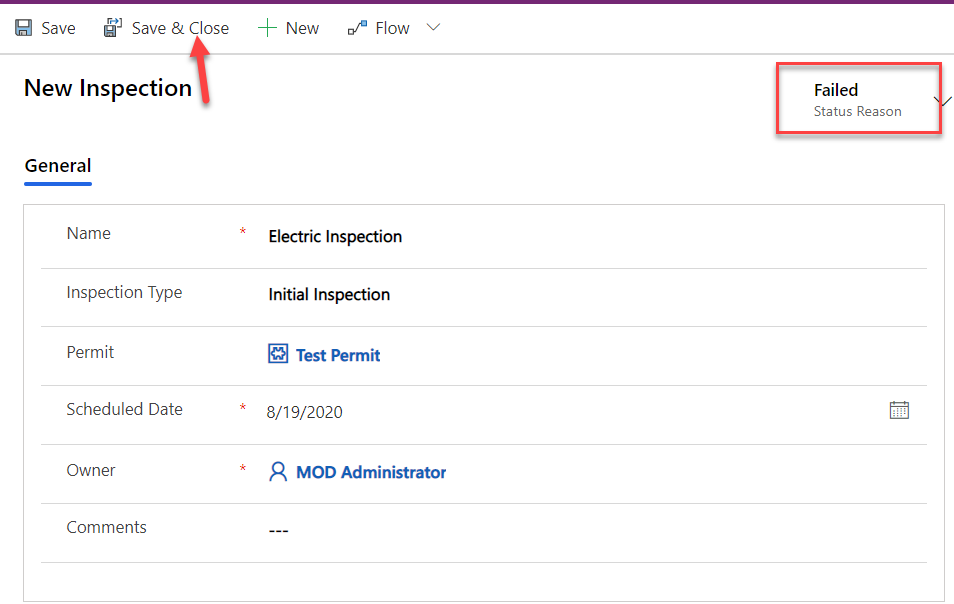
- Close Advanced Find.
-
-
Test the control
- Open a Permit record.

-
Select the Inspections tab.
-
The control should show the two inspections, but the color will not match the status reason values.
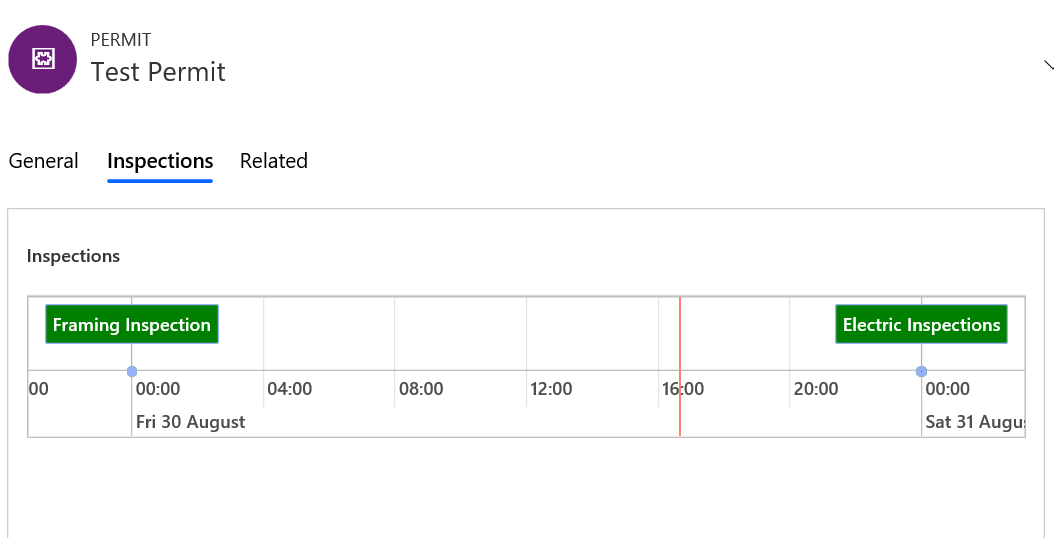
Task #3: Debug
-
Start Edge DevTools and add breakpoint.
-
Press F12.
-
Search for createTimelineData = function
-
Locate the createTimelineData function and add breakpoint on the permitColor =”green” line.

- Go back to the Permit Management application and click Refresh.

-
Select the Inspections tab again.
-
Execution should break.
-
Hover over the permitStatus, the permitStatus is null because Status Reason is not included in the View.

-
Press F5 to continue.
-
Close the DevTools.
-
-
Add Status Reason to the view.
-
Go back to the form editor.
-
Double click on the Inspections timeline control.
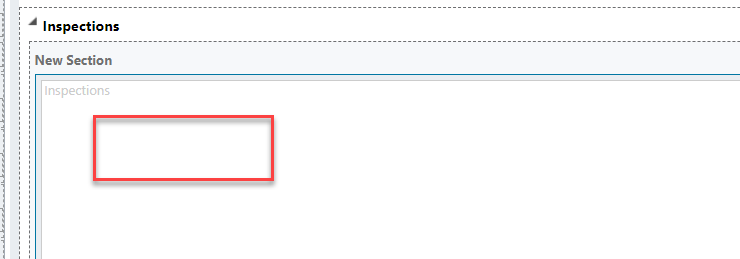
- Select Edit.
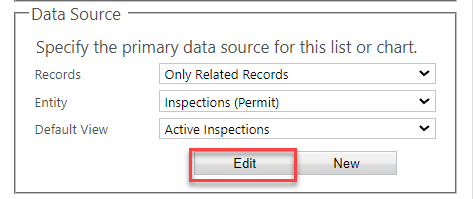
- Select Add Columns.
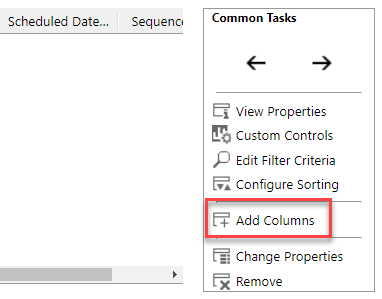
- Select Status Reason and select OK.

- Move the Status Reason column after the Name column.

-
Select Save and Close.
-
Select OK.
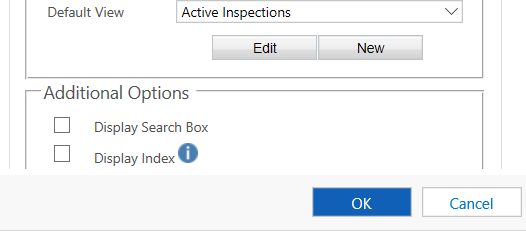
-
Select Save.
-
Select Publish and wait for the publishing to complete.
-
Close the form editor.
-
-
Test your changes
- Go back to the Permit Management application and refresh the browser.

- Select the Inspections tab. The timeline control should now show the correct colors.

Task #4: Add the Timeline Control to Permit Management Solution
-
Add Custom Control to solution
-
Navigate to Power Apps maker portal - screenshot and make sure you are in the Dev environment.
-
Select Solutions and open the Permit Management solution.
-
Select **Add Existing More Developer Custom Control**.
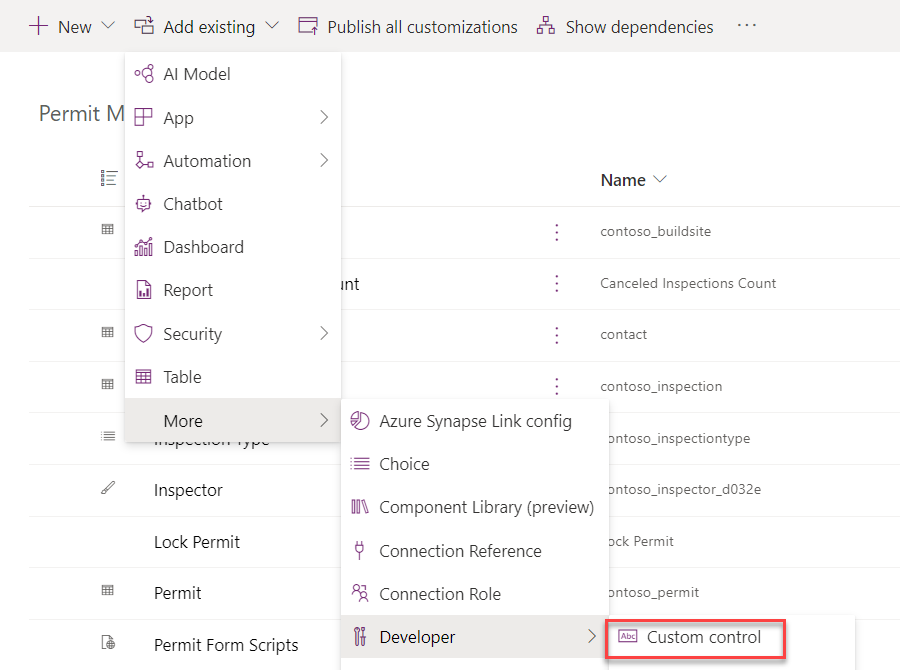
- Search for Timeline, select contoso_contoso.timelinecontrol and select Add.
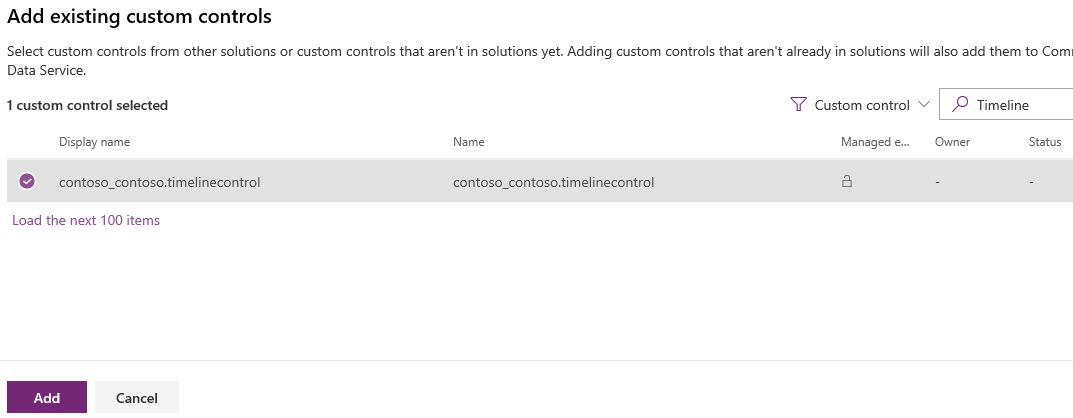
- Select Publish All Customizations and wait for the publishing to complete.
-
Exercise #3: Promote to production
Objective: In this exercise, you will export the Permit Management solution from your Dev environment and import it into your Production environment.
Task #1: Export Solution
-
Export Permit Management managed solution
-
Log on to Power Apps maker portal and make sure you are in the Dev environment.
-
Select Solution.
-
Select the Permit Management solution and then select Export.

- Select Publish and wait for the publishing to complete.
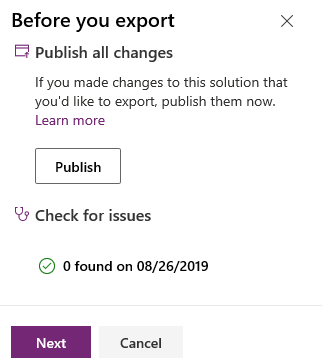
-
Select Next.
-
Select Managed and then select Export.

- Save the Exported solution on your machine.
-
-
Export Permit Management unmanaged solution
-
Select Solution again.
-
Select the Permit Management solution and then select Export.
-
Select Next.
-
Select Unmanaged, edit the version number to match the Managed Solution you just exported and select Export.
-
Save the Exported solution on your machine.
-
Task #2: Import Solution
-
Import Permit Management managed solution
-
Log on to Powe Apps maker portal and make sure you are in the Prod environment.
-
Select Solution.
-
Select Import.

-
Click Choose File.
-
Select the Managed solution you exported and select Open.
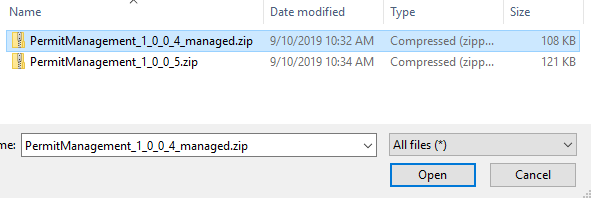
-
Select Next.
-
Expand the Advanced settings area and make sure Upgrade is selected.
-
Select Import and wait the import to complete.
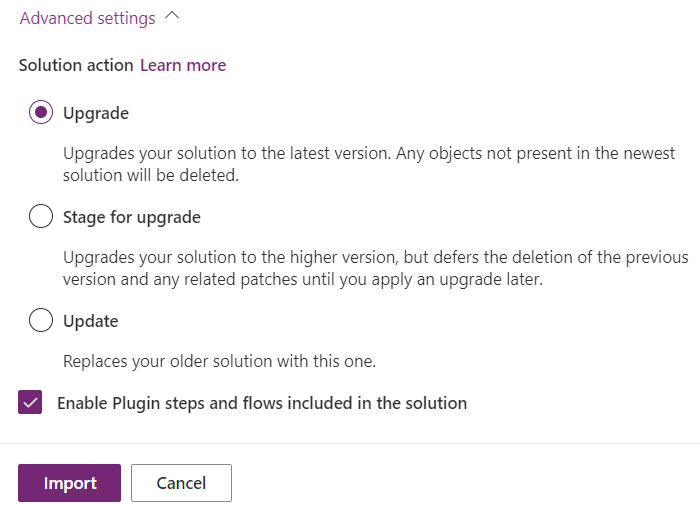
-
Review the production application by adding a few records and testing your progress.